Venezuera
Current Status of Sediment-related Disasters and Countermeasures for Them in Venezuela
Masaichi Nagata (JICA’s expert dispatched to the Department of Disaster Prevention, in the Ministry of the Interior and Justice in Venezuela and the Disaster Prevention Bureau, the Capital District of Caracas)
1. Introduction
Venezuela faces the Caribbean Sea and is located on the opposite side of the globe from Japan, with a 13-hour time difference that limits the amount of information on the country that is conveyed to Japan. Among the Japanese, Venezuela is seen as a prosperous oil producer with rich natural resources as symbolized by Table Mountain. The capital Caracas was filled with high-rise buildings in the 1970s, at which time expressways were also developed. Thereafter, Venezuela experienced several ills including explosive population growth, progressive urbanization, increasing poverty, devastation of mountain slopes, political turmoil and social disruption. Due to such difficulties, sediment-related disasters and flooding are major, immediate problems for the nation’s citizenry.
In particular, disasters caused by torrential rainfalls in recent years affected many residents and were responsible for massive damage to roads and other infrastructure, which had a great impact on the entire country.
The Japanese government provides assistance concerning disaster prevention techniques at the request of the Venezuelan government. As part of this program, I was dispatched to the Department of Disaster Prevention in the Ministry of the Interior and Justice in Venezuela and the Disaster Prevention Bureau in the Capital District of Caracas in August 2004, and have worked with them ever since. I would like to present here the current status of sediment-related disasters and countermeasures in Venezuela.
2. Outline of Venezuela
2.1 Status of Venezuelan society
Venezuela is located at the north end of South America, situated between 0 and 12 degrees North Latitude and between 60 and 73 degrees West Longitude, bordered by the Caribbean Sea to the north, Columbia to the southwest, Brazil to the south and Guiana to the east. The country attained independence from Spain as Gran Columbia (identifying the northern South American countries) in 1811, and became independent from them in 1830. It is officially called the “Bolivarian Republic of Venezuela (República Bolivariana de Venezulea)”.
The country covers an area of approximately 910,000 k m2, about 2.5 times as large as Japan (including disputed territory bordering Guiana). It has a population of about 23 million, or about 20% the size of Japan’s population. The capital of Caracas has a population of about 3 million, and about 90% of the total population is concentrated in urban areas.
The country is very rich in natural resources and has staple industries such as oil and gas. In particular, oil, being key to the country, accounts for about 50% of the state revenue and about 80% of the total exports. However, the production of oil was suspended due to the general strike in 2002, which caused massive confusion in the market due to lack of resources such as food articles and gasoline. Due to oil wealth and a disregard for agricultural policies, enormous numbers of people rapidly left rural areas for cities, which caused an increase in slum areas, a shortage of housing and sanitary accommodations, confusion of social infrastructure and devastation of mountains and forests. In economic terms, industries other than oil are not being developed, forcing the country to import wheat and other foodstuff in spite of Venezuela’s vast arable land. The ratio of poor families in Latin American countries is decreasing, but the population of poor is still ion the increase in Venezuela.
As a result of such policy, a huge number of people entered cities, and mainly Caracas, which created a great number of poor, forming large-scale slums (called Rancho) on slopes of urban areas and near rivers where there is a high potential for disaster. These slums are increasing. Three quarters of Caracas’ population is currently dominated by Rancho area residents. These areas receive people from rural areas, and yet have become a hotbed of crime. In addition, many people from Columbia and other neighboring countries have illegally entered Venezuela, so that millions of illegal immigrants live across the country.
In ethnic composition, it is said that mixed people of Spanish descent account for about 70% of the total of Venezuelan people, with about 20% caucasian, 10% of African descent and 2% indigenous peoples. Whites of Spanish and Italian descent dominate the upper reaches of many fields such as politics and economy.
Many people believe in Catholicism. Parroquia, or parish, i.e. the smallest administrative unit of the Church, was in fact turned into an organizational unit of the federal government.
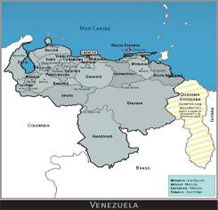
Fig. 1. General overview of Venezuela
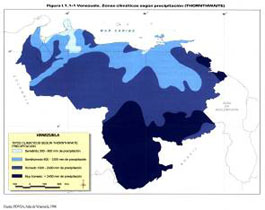
Fig. 2. Rainfall distribution map for Venezuela

Fig. 3. Monthly average temperature and rainfall in Caracas (1964-1990)
2.2 Outline of topography and climate
Venezuela is roughly divided into 5 regions, 1) the Northern Mountain Region, 2) the Maracaibo Lowland, 3) the Orinoco Region, 4) the Guiana Highland and 5) the Caribbean Islands, each with their own characteristic topographical features.
The Northern Mountain Region is located in mountainous areas composed of the coastal mountain range running east to west along the coast of the Caribbean Sea (highest peak: Naiguata at 2,765 m) and the Andes’ lateral extension running to the west of Columbia (highest peak: Pico Bolivar at 5,007 m). The major cities, which include the capital of Caracas, Maracaibo, Valencia and Barquisimeto, are concentrated in this region. These cities stretch to the bases of steep mountains, while villages formed on alluvial fans in their suburbs. Many forests in this region were cut to use the mountain slopes for grazing and agriculture. For this reason, the devastation of catchment areas is being developed, which often causes sediment-related disasters. In order to prevent such disasters, the construction of small sabo facilities and tree planting have been implemented. In Caracas, culverts have been installed on small rivers flowing from mountains, which just increases the likelihood of disaster.
The Maracaibo Lowland is a low-lying area around the Maracaibo Lake that is the largest lake in South America with an area of about 13,000 km2. This salt lake and its surroundings are one of the largest oil regions in the world. In addition, the area is often inundated for a long periods due to flooding from the upper reaches of the Andes.
The Orinoco Region includes low-lying Savanna areas that stand 50-200m above sea level, called the Orinoco delta and Llanos. A sand bed, which was formed by the accumulation of erosion-susceptible soil, extends to the middle and lower reaches of the Orinoco River, and contains ultra-heavy oil called Orinoco Tar.
The Guiana Highland is a hilly zone at 1,000-2,000m altitude above sea level, located in south of the Orinoco Region. The zone’s lower layer is a lava bed on which sits a sandstone bed about 2,000m thick. After the gradual erosion of the upper sandstone bed, hilly highlands called Table Mountains can be seen. Also located in this zone is Angel Fall (a drop of 979m), which boasts of the greatest head drop in the world.
The Caribbean Sea is interspersed with about 70 islands such as the Margarita Islands and Los Roques Islands.
Venezuela geographically belongs to the tropics, but is divided into 5 regions, which feature the climates of 1) Tropical Savanna, 2) Tropical Rainforest, 3) Dry Tropics, 4) Tropical Highland and 5) Cold, depending on sea level altitude, trade wind and topography.
Most of the territory belongs to the tropical savanna climate that is divided into rainy (May to November) and dry (December to April) seasons, and has a temperature of 20 degrees Celsius or more throughout the year. The annual average rainfall in Caracas reaches 916mm, and 85% of the precipitation is brought in by the rainy season. The difference between the minimum (20.2 degrees Celsius in January) and maximum (22.7 degrees Celsius in September) of the monthly average temperature is only 2.5 degrees Celsius (Fig. 3).
The tropical rainforest climate zone includes the lower reaches of the Orinoco River, the southern Amazon region, the southwest region of the Maracaibo Lake and so on, while the hot-arid zone covers coastal areas facing the Caribbean Sea. The tropical highland climate zone includes the Guiana Highlands at 1,000-3,000m of altitude above sea level and the Andes, and is characterized by warm and humid climates. The cold climate zone covers a region of the Andes at 3,000m or more altitude above sea level. The areas 4,700m or more of altitude above sea level are enshrouded in eternal snows.
Looking at rainfall distribution, the northwestern area facing the Caribbean Sea is an arid zone with 600mm or less of annual rainfall. The rainfall increases as we go further southward to the inland. In the Amazon area boarding Brazil, the annual rainfall exceeds 2,400mm (Fig. 2).
During the rainy season, Venezuela is assaulted by heavy downpours of relatively short duration (about 1 to 3 hours). In addition, it seldom rains all day, while raining almost locally.
3. Sediment-related Disasters
3.1 History of Sediment-related Disaster Prevention Works
It was reported that a project for measures against sediment-related disasters was launched during 1940s. At the beginning of the project, the USA’s mission related to soil conservation was said to survey actual slope erosion in the Los Andes region and recommend measures against the erosion.
Thereafter, the Soil and Water Conservation Department was created within the Ministry of Agriculture and Livestock during the 1950s and it implemented a project for restoration of forests mainly in the Los Andes.
Sabo works were conducted on a large scale after channels were constructed at the basin of the Chama River in Merida Province under the technical guidance of Australia during the 1970s. In 1977, the Ministry of Environment and Natural Resources was established as a government organization that administers environment, water resource development, rivers and their basins.
3.2 Implementation of Sabo Works
Sobo works are governed by the Ministry of Environment and Natural Resources. The ministry takes charge of erosion control works, soil conservation works and so on, in addition to sabo works, and is able to promote comprehensive sediment control for a whole basin. However, rapid progress has not been made in constructing facilities for these works due to the limitation of budgets and other resources. These facilities are often established by road administrators, electric utilities, waterworks administrators and other organizations. Only small-scale sabo dams were constructed (Picture 1). For reference, the reconstruction work for the 1999 Vargas Disaster was implemented by the Vargas Reconstruction Agency (Picture 2).
Now, the government is establishing VENEHMET, a new organization that controls meteorological information for the whole country as a special department of the Ministry of Environment and Natural Resources, and is also planning to upgrade and expand non-structural efforts such as through the establishment of information systems for disasters.
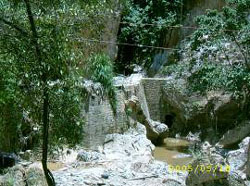
Picture 1 Normal sabo dam
(Branch of Guaire River)
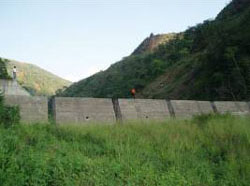
Picture 2 Concrete slit dam
(Vargas Province)
4. Disasters in Recent Years
4.1 Vargas Disaster in 1999
In December 1999, a cold front caused a heavy downpour in Vargas Province along the Caribbean Sea. According to the observations of the Miquetia International Airport, a rainfall of 920mm was recorded for three days from the 14th to the 16th, a cumulative rainfall of 1,240mm in December (annual average rainfall of 540mm). The heavy rainfall evoked debris and sediment flows, slope failures and inundation and destructed numerous houses, bridges and other structures. It was estimated that about 30,000 to 50,000 people were missing and dead in this catastrophic disaster. Individual study teams from Japan and other countries shared surveys on the reality of disasters in different areas. In the San Julian River (a catchment area of 21.92 km2) covered by the Japanese study team, an amount of soil collapsed of mountain slope and that of sediment in its alluvial fan were estimated to reach 767,000 m3 and 1,627,000 m3, respectively. The amount of sediment in the alluvial fan greatly damaged from 13 torrents reached 7,200,000 m3. The outflow of a vast amount of sediment pushed coastline forward 50-100m in many torrents (Picture 3.4).
Vargas Province experienced the same disasters also in July 1948 and in February 1951. The 1951 Disaster caused about 1500 victims. The area of Vargas was developed as a coastal resort for the rich in recent years, and was promoted to the status of province in 1998. Most of the victims were the poor, such as workers for the facilities. Most of their houses were located in zones with high potential for disaster. The rapid expansion of resort development and the insufficiency of disaster prevention required by the development caused great damage to the province.
Currently, the Vargas Reconstruction Agency is leading reconstruction works. In order to establish sabo facilities, the agency is focusing on the construction of gabion check dams, in consideration of the government’s budget and employment promotion (Pictures 5 and 6). The work progress is not fast, so it is difficult to say that the recommendations are fully used.
This zone, as mentioned later, suffered a great disaster also in February 2005.

Picture 3. Situation immediately after the disaster in the alluvial fan of the San Julian River
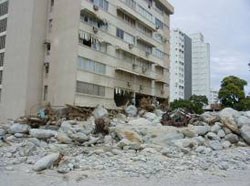
Picture 4. Damaged buildings and deposited sediment (immediately after the disaster)
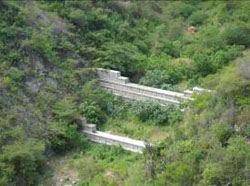
Picture 5. Gabion check dam
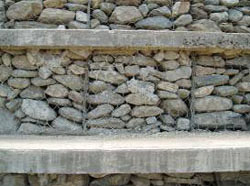
Picture 6. Construction of gabion check dam
4.2 Disaster in February 2005
A powerful cold front that had developed in the Caribbean Sea caused a heavy rain with a total rainfall of up to 300mm on the seacoast on which the population and economic activities of the country are focused, and in a wide range of the Andes area in the west, for about a week from February 6, 2005. Cumulative rainfall during the five days from the 6th to the 10th reached 304mm at the Miquetia International Airport in Vargas Province.
This heavy rain during a dry season caused wide-ranging damage to great areas of 10 provinces and the capital district, 122 deaths and missing persons, affected about 220,000 people, and damaged about 40,000 houses (data from the Ministry of Interior and Justice). In addition, it disconnected or washed away roads and broke dykes in various regions.
4.2.1 Disasters in Vargas Province
Debris flows occurred at many torrents in Vargas Province, discharging a large amount of sediment to the coast and causing damage to about 40,000 people. In this disaster there were few collapsed mountain slopes, but sediment that had accumulated in high volume in the riverbeds due to rainfalls in 1999 and earlier seemed to be released.
In particular, an alluvial fan in the lower reach of the Camuri Grande River, being located in the east of the province, received a large amount of sediment. The former river channel was blocked with the sediment, which accumulated 1-2m thick mainly on the right bank, damaging many homes. Most of the affected areas in the basin of this river experienced damage from the 1999 disaster in the same manner. In the wake of the previous great disaster, a plan for sabo works was developed, but the execution of the works was not quite finished. In the future, it is necessary to establish sabo facilities earlier in this river (Picture 7 and 8).
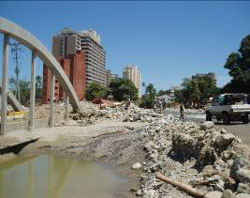
Picture 7. Bridge filled with sediment
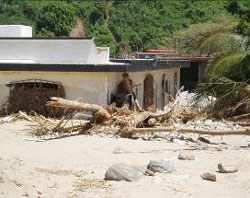
Picture 8. Damaged house and accumulated sediment
The San Jose de Galopan River, being located in the center of the province, caused the outflow of a large amount of sediment during the 1999 disaster, but sabo dams and channel works were constructed after that. Consequently, the river experienced few disasters under this heavy rain. A sabo dam at the lowest reach of the river had extra room available last October, but was filled with sand after this disaster (estimated capture of about 11,000 m3). This is a good case in which a sabo facility was seen to have had a visible effect (Picture 9).
Among sabo dams constructed, it was seen that a sabo dam could not exert its capabilities due to the insufficient intrusion of its arm. For instance, small check dams that are placed along main roads of Camuri Chico discharged a large amount of sediment without capturing the sediment because its arms were both eroded. In this case, insufficient consideration seems to be given to the state of base ground and natural ground of the arms in constructing the check dams. The same erosion of sabo facilities could be confirmed at other places (Picture 10).

Picture 9. San Jose de Galopan River
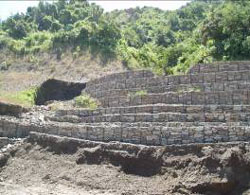
Picture 10. Small check dam with arm eroded (Camuri Chico)
4.2.2 Disasters in the Capital District of Caracas
Most disasters in the capital district of Caracas occurred in the large-scale Rancho slums, causing 4 deaths and missing persons and affecting 15,000 people. Cumulative rainfall in the built-up area of Caracas for the 4 days from February 7th to the 10th reached 172mm (observation by the Air Force). For this reason, the overflow of the river in the center of the area discharged sediment to an express highway and closed it. This greatly affected the urban functions of the capital. As a result of this, public schools and other facilities were closed for a week.
In the zone of 19 de Abril, a large-scale landslide occurred on February 10th and almost collapsed 230 houses. The affected area was equivalent to about 10,000 m2. Here, the same disaster had occurred 20 years ago, but measures against landslides were not taken after that (Picture 11).
In the zone of Antimano, a large-scale Rancho is formed on the old site of a stone pit. This heavy rainfall caused some failures and damaged 188 houses. In addition, the zone has large-scale landslide activities in the whole zone and more disasters than before (Picture 12).
Most of the areas affected by this disaster have many points at which a small-scale failure and a landslide occurred more frequently than before. Numerous small failures occurred around the affected areas, so there is a significant risk that future rainfalls will expand a range of the devastated zone. Most of the affected areas belong to Rancho. In order to prevent these disasters, the establishment of a disaster forecasting and warning system for prompt evacuation is being considered.
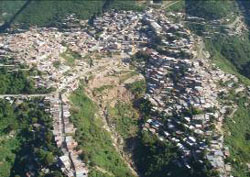
Picture 11 Zone of 19 de Abril
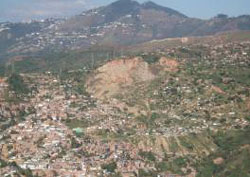
Picture 12 Zone of Antimano
In addition, many failures occurred even on the slope of an express highway, resulting in the closure of the highway. Sediment on the road was immediately removed, but each rainfall expanded the collapse of the slope, which activates landslide activities. Currently, steel pipe piles are being placed as control works for preventive measures against landslides, while a plan for the replacement of a bridge section in the road is being reviewed (Picture 13 and 14).
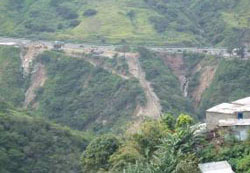
Picture 13 Collapse of a downstream
slope of the highway
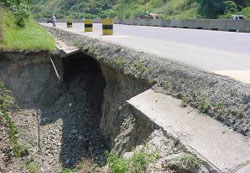
Picture 14 Eroded subgrade of the highway
4.2.3 Disasters in the Western Andes Region (Merida, Tachira and Zulia Provinces)
In the Andes Region, numerous hillside collapses occurred, so a debris flow fell through a village in the alluvial fan and caused great damage to the village. In addition, the Maracaibo Lowland, downstream from the region, experienced a long-term inundation. These three provinces had a total of 99 deaths and missing persons and about 130,000 victims. In Sta.Cruz de Mora of Merida Province, a debris flow fell through a village and caught buses at a bus terminal (Picture 15). Furthermore, numerous collapses occurred upstream from the Onia Dam near El Viga, so a large amount of sediment and wood flowed into the dam (Picture 16).
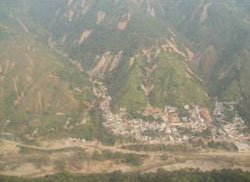
Picture 15. Zone of Sta.Cruz de Mora

Picture 16. A large amount of sediment that flowed into the Onia Dam
In the upper reaches of the Escalante River running through both of Tachira and Zulia Provinces, on which many collapsed areas were concentrated, a large amount of sediment and woody debris moved downstream as a debris flow (Picture 17). In addition, in La Fia of Tachira Province, a large-scale collapse occurred, so a debris flow caused damage to this town (Picture 18). The Andes Region experienced many collapses on farmland and mountain ranches. The disaster expanded because sufficient drainage and erosion prevention measures had not been taken on sloped agricultural land.
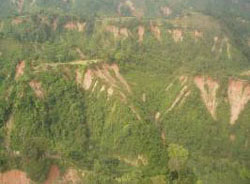
Picture 17. Collapse in the upper reaches of the Escalante River.
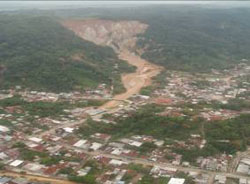
Picture 18. Collapse in La Fia
5. Future Challenges and Efforts
In Venezuela, post-disaster prevention measures are taken, but few preventive measures against disasters are taken. Sabo dams have been constructed, but small-scale sabo dams with a width of a few meters were mainly constructed and there was a small number of construction works. In terms of dam types, masonry and steel frame dams are often constructed, but a concrete dam is not often established due to the high price of concrete.
The disaster-affected points in Caracas are focused on the environs of Rancho, where houses are heavily built on steep slopes and closely also along a torrent. Under Caracas’ municipal by-law, dwelling construction on steep slope is regulated, but houses in Rancho are illegally occupied, which cannot be effectively regulated. In addition, few drainage channels for dense houses are established, so miscellaneous wastewater from the houses erodes the slope and promotes failures and collapses. Even when a slope failure occurred closed to houses, special measures against the collapse were not taken. For this reason, the collapse is expanded every time it rains. Measures in consideration of previous landslide disasters and other disaster records and previous land use (dumpsite, quarry, etc.) were not fully taken, which increases the number of damaged points. The administrative organization conducts reconstruction efforts for disaster-affected points, but cannot afford to take disaster prevention measures such as sabo dams and landslide control and restraint. However, the organization offers a system for helping affected people in which they can move into public housing with a total collapse certificate issued by the Disaster Prevention Department when their houses are completely damaged. Affected points are sometimes specified by the administrative organization, as dwelling construction is regulated after disasters. After a few years, however, new houses are built, so the same disaster is repeated.
The outskirts of the city experienced many slope failures resulting from mountain ranches and farmland, roads and other places, but insufficient drainage and erosion prevention measures are taken when using agricultural land on slope and constructing roads. Only a few forest improvement and erosion protection works for mountain farmland were implemented.
The Vargas Province executed reconstruction works for the 1999 disaster, and is recently constructing more sabo facilities than other districts. After the 1999 disaster, sabo plans for many torrents were formulated with the help of various countries, but these plans for the construction of sabo facilities were not put into practice earlier. In addition, it is seen that a construction work was different from that proposed in the plan. The previous disaster was a giant stone-containing debris flow disaster. For this reason, a concrete sabo dam that is resistant to the impact force of a debris flow was predominately planned. A gabion dam, however, is often built in order to reduce construction costs and promote local employment. Unfortunately, it seems that construction works are not fully conducted in accordance with each base ground and natural ground, which causes erosion of dam arms.
Currently, the central government holds the meeting of committees and their pertinent organizations, strengthens the national and local governments’ organizations and enhance measures against disasters, in order to promote disaster prevention works. In addition, the government is considering the establishment of a disaster prevention information system including the creation of a national disaster prevention center, referring to a Japanese information system for disaster prevention.
In order to formulate regional disaster prevention plans, the Capital District of Caracas has been conducting the “Survey on Basic Disaster Prevention Planning in the Metropolitan Area of Caracas” (JICA’s Development Study) since 2002, preparing hazard maps, installing telemeter rain gauges and water gauges, providing disaster prevention education to local residents and so on (Fig. 4 and Picture 19).
The central government now focuses on non-structural measures against sediment-related disasters, considering social and financial situations and other factors in Venezuela. Technical cooperation from Japan will become more important when establishing future non-structural measures and structural measures.
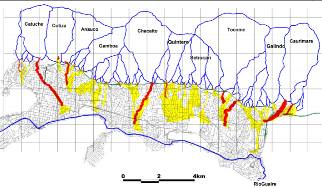
Fig 4 Hazard map in the center of Caracas
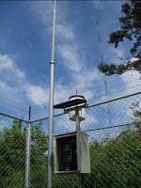
Picture 19 Telemeter using cellular phones